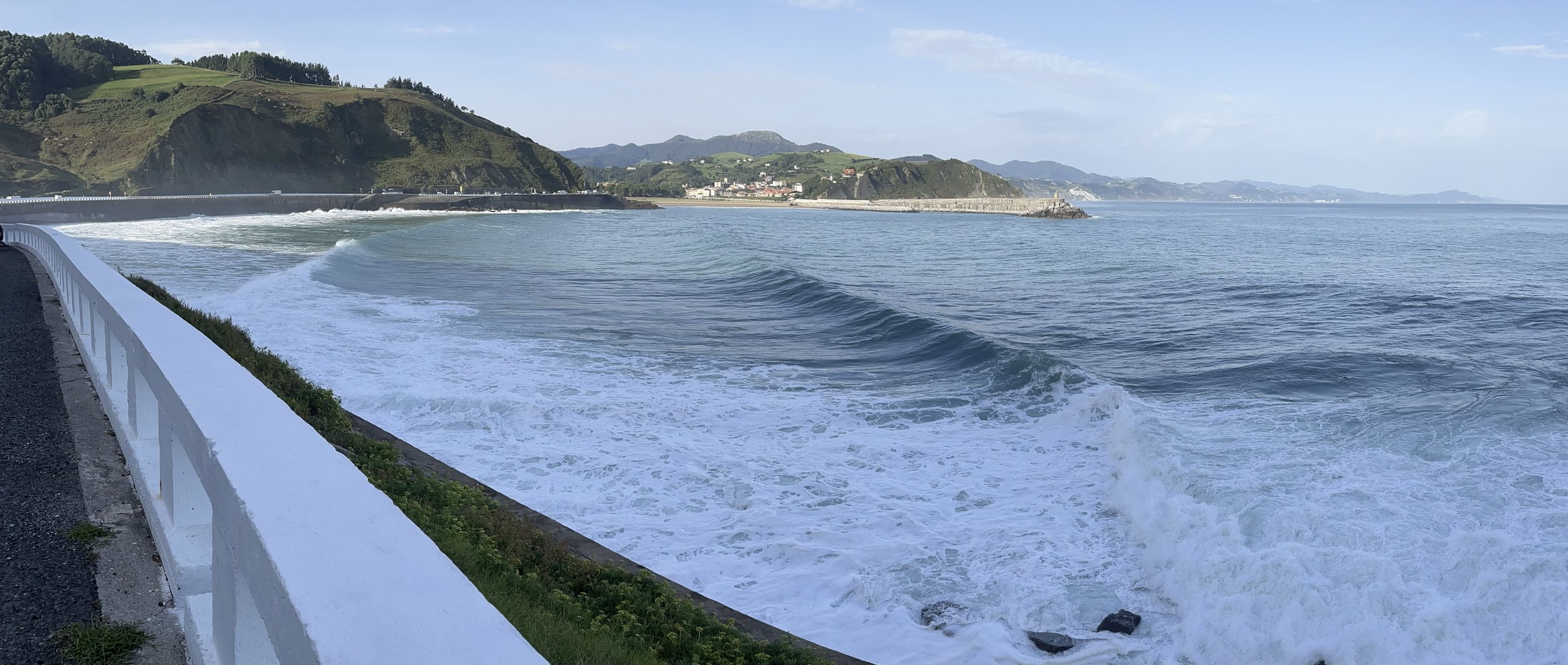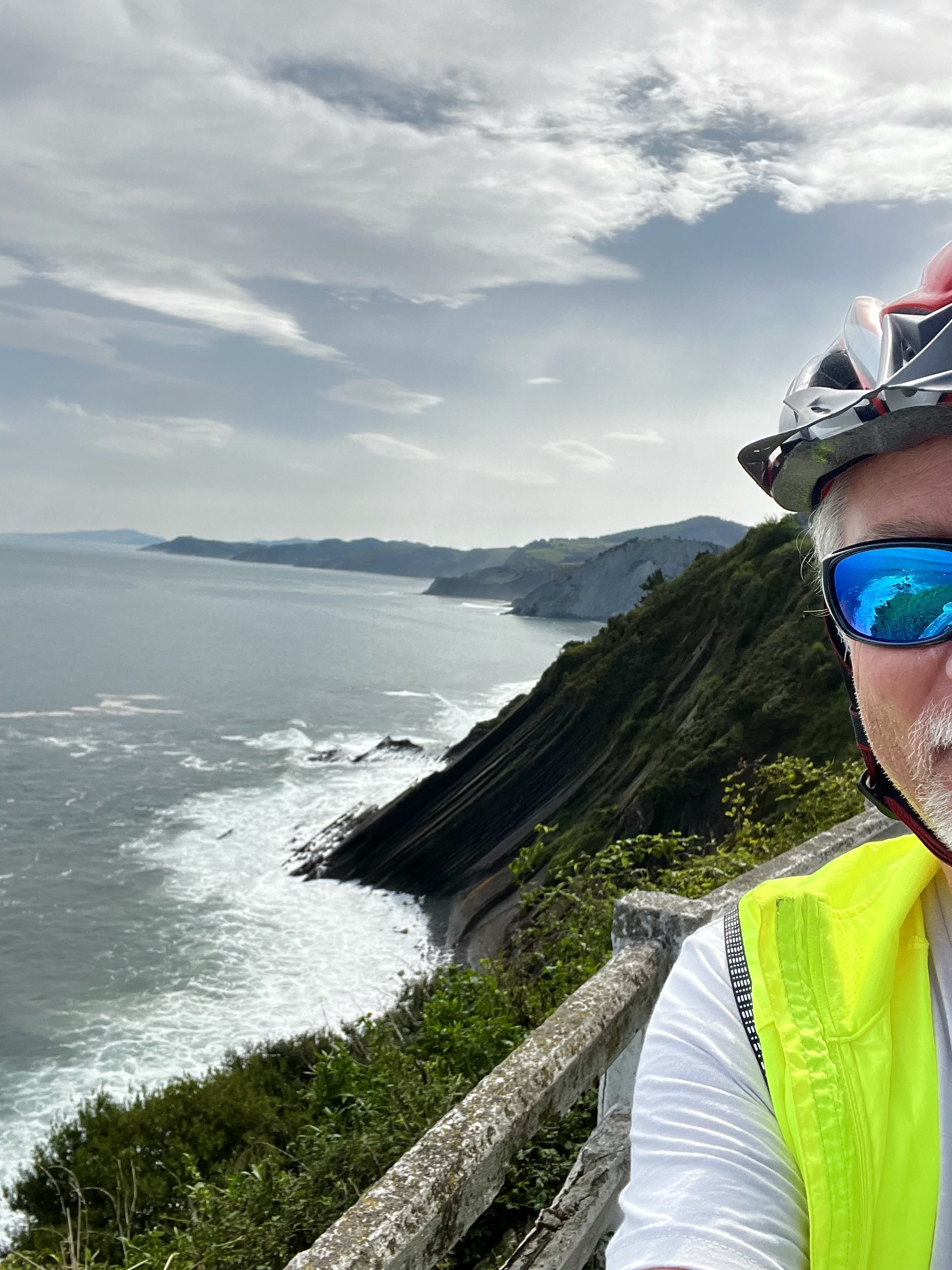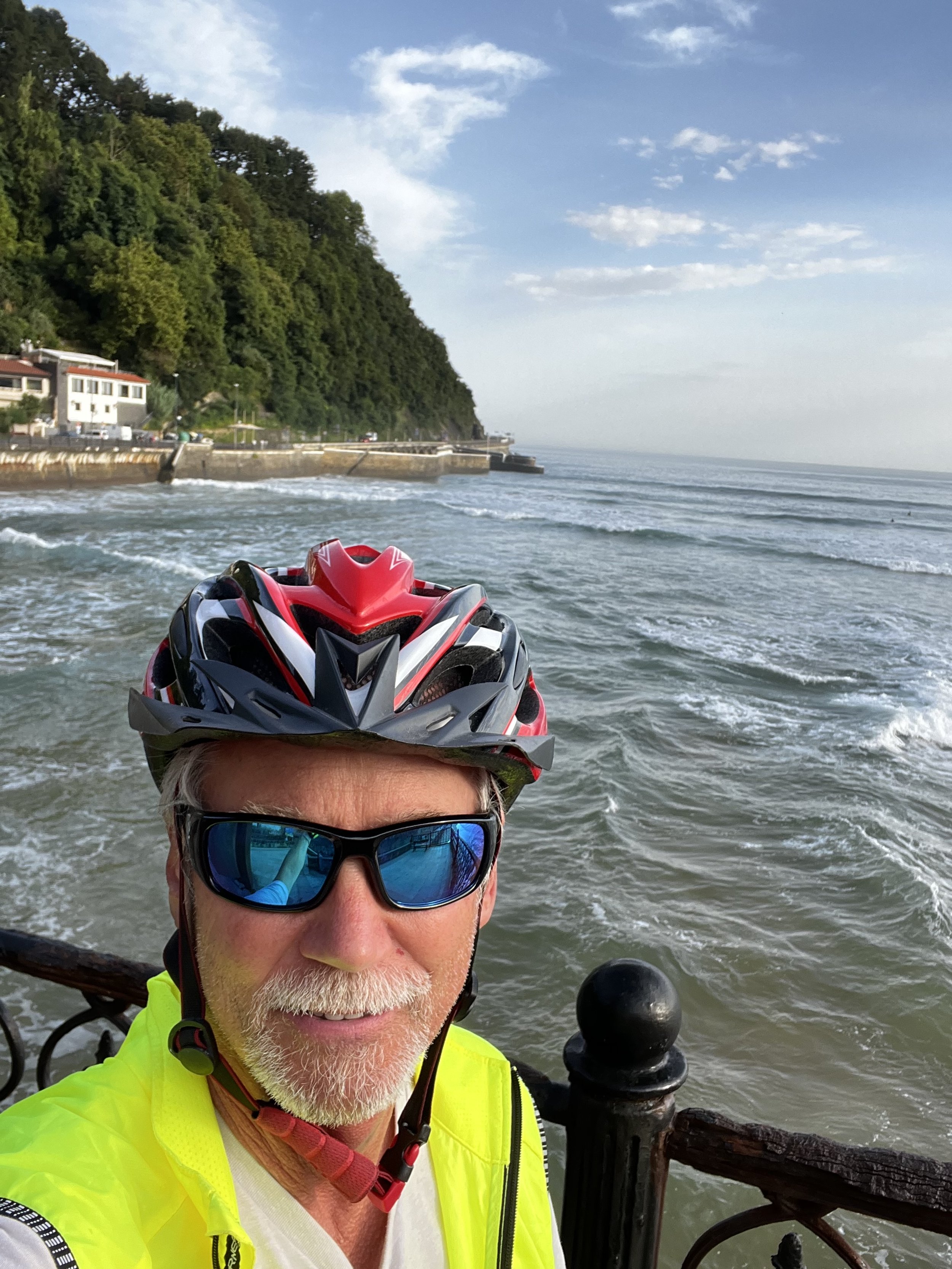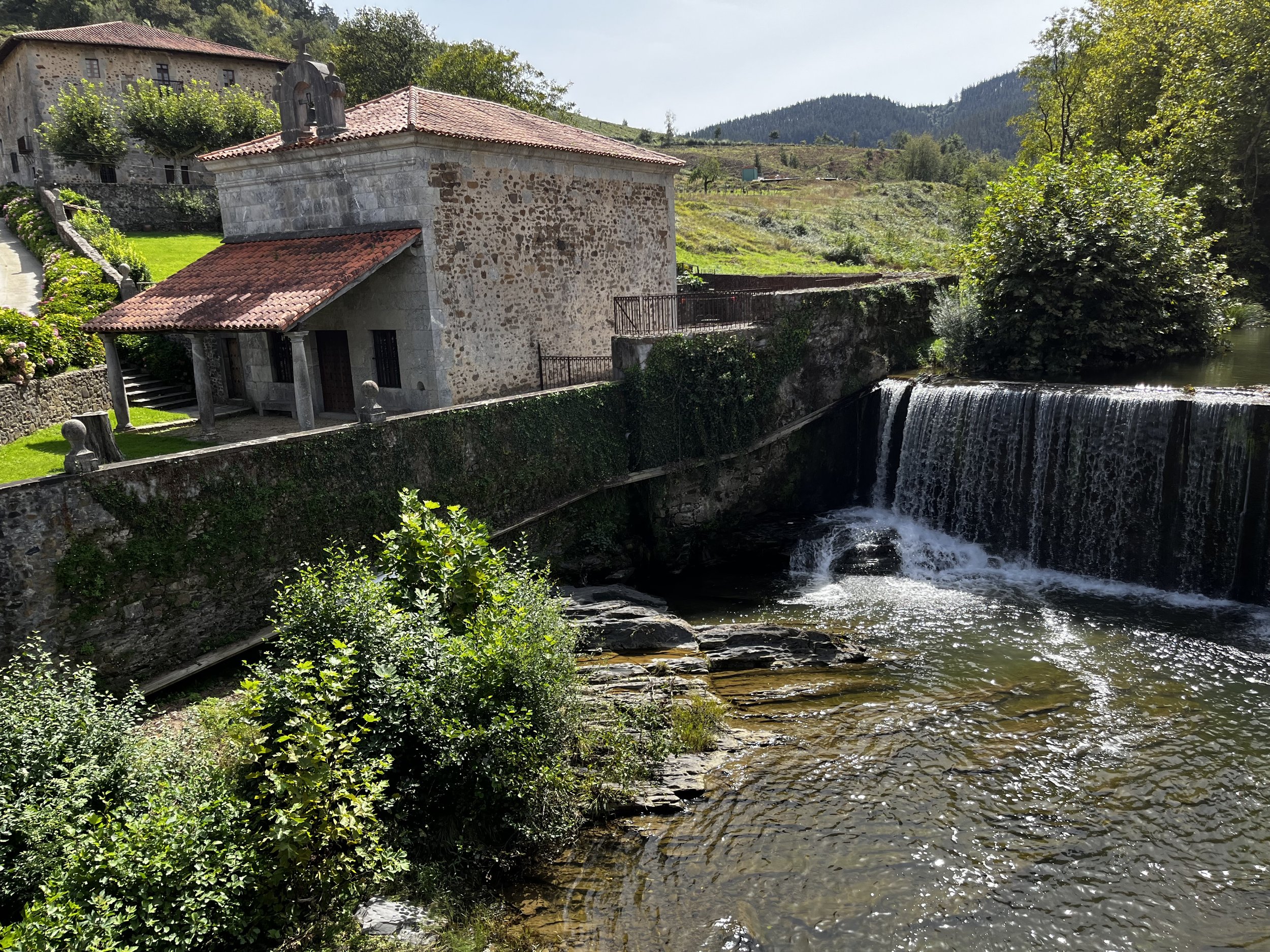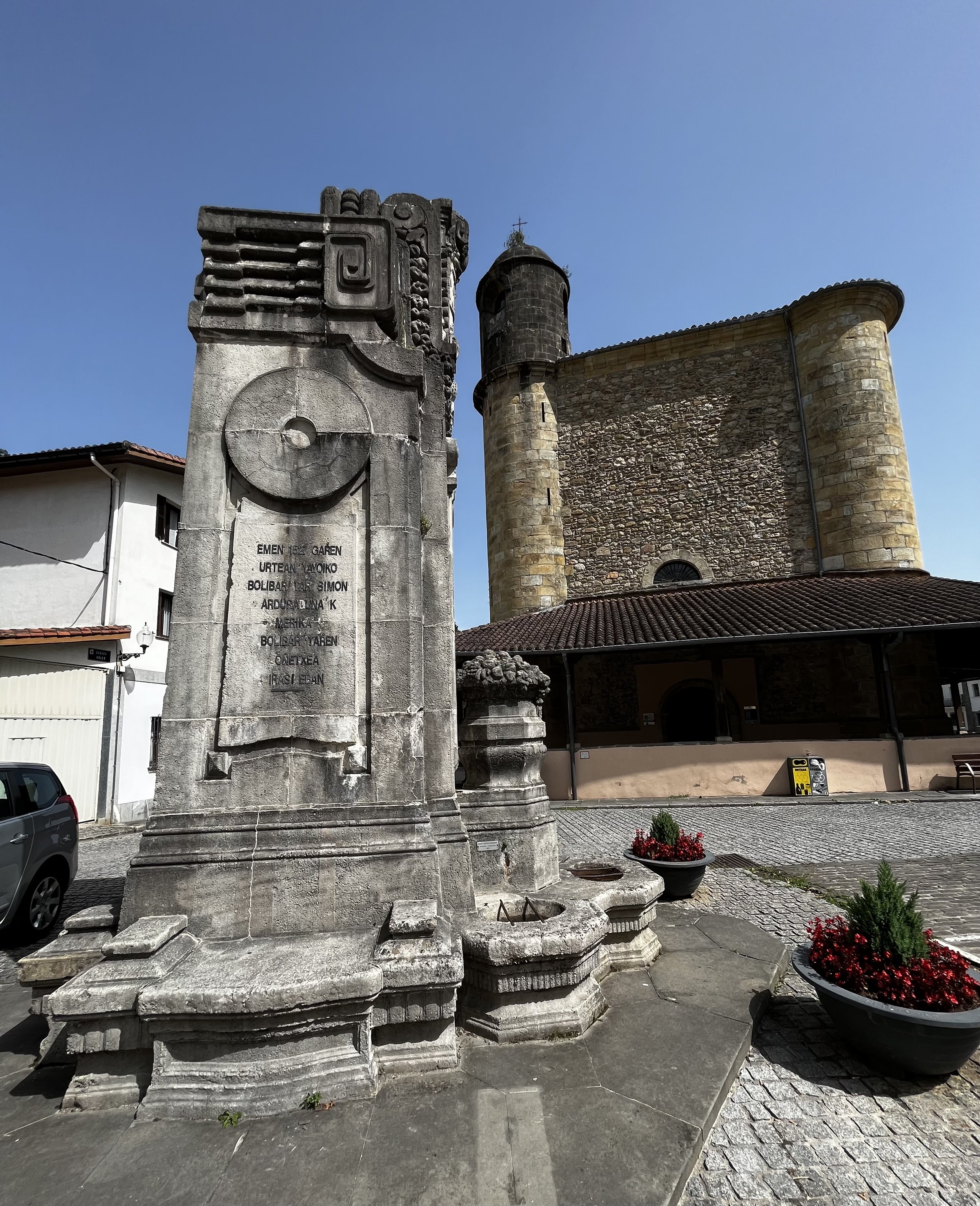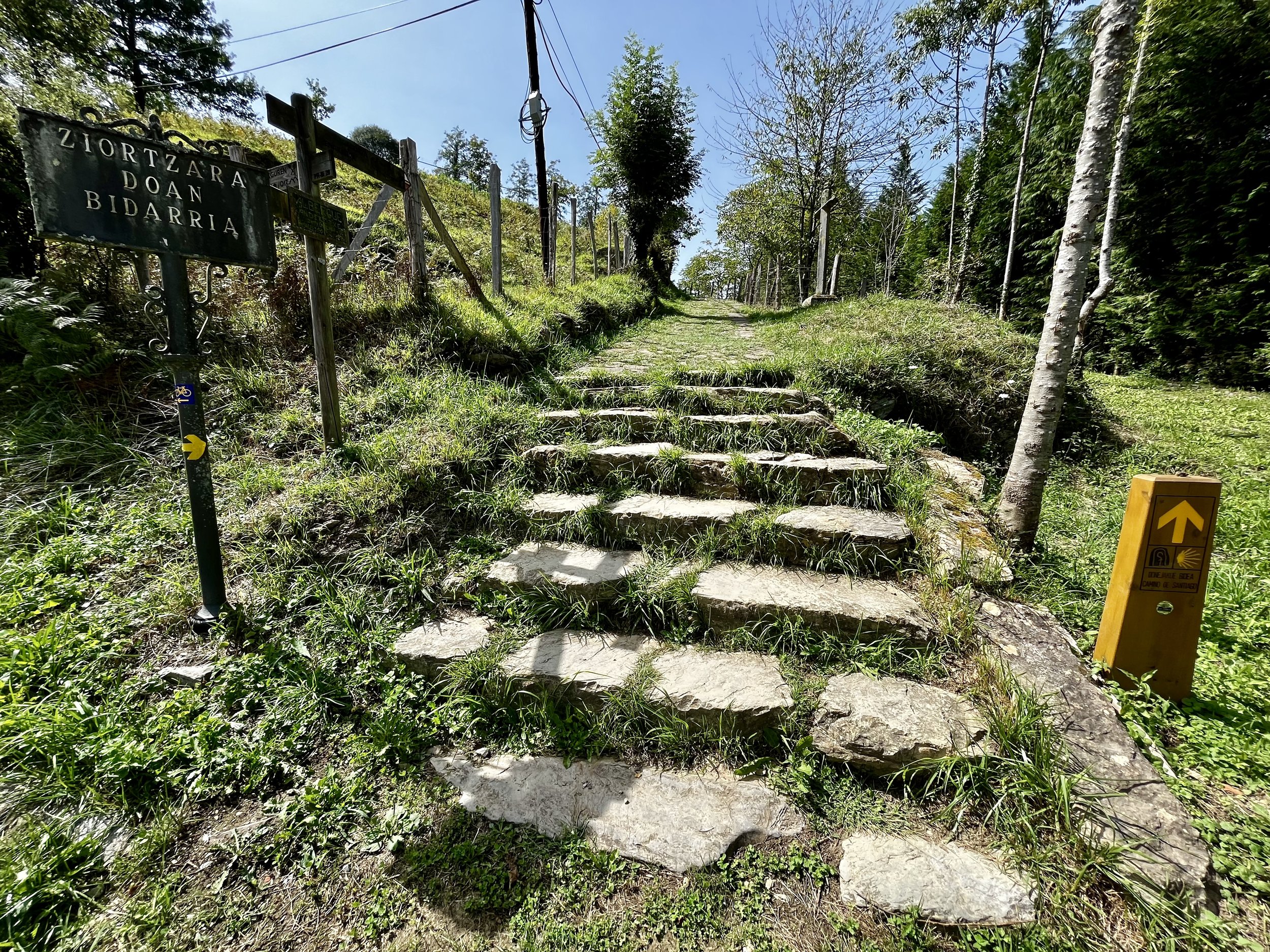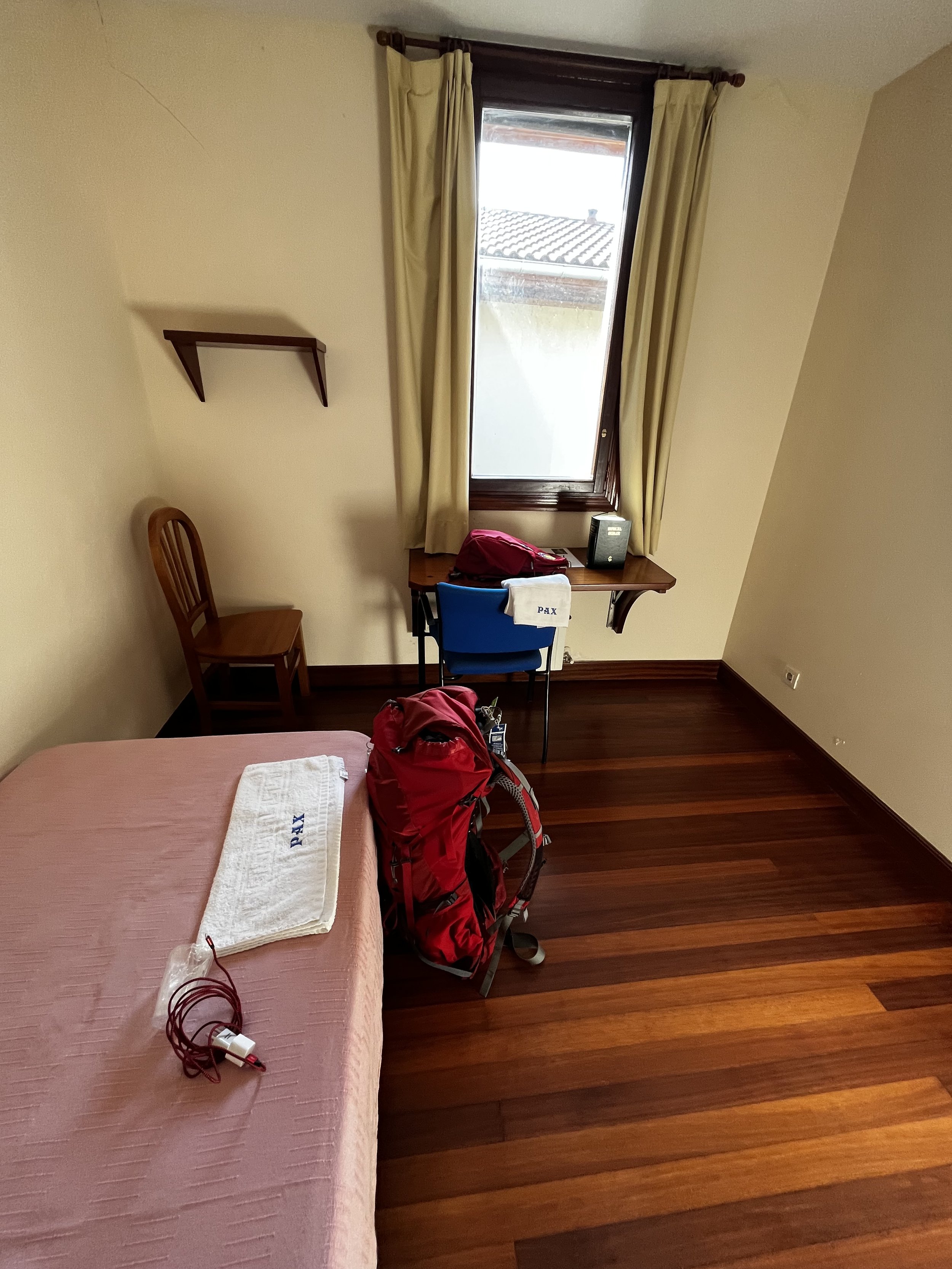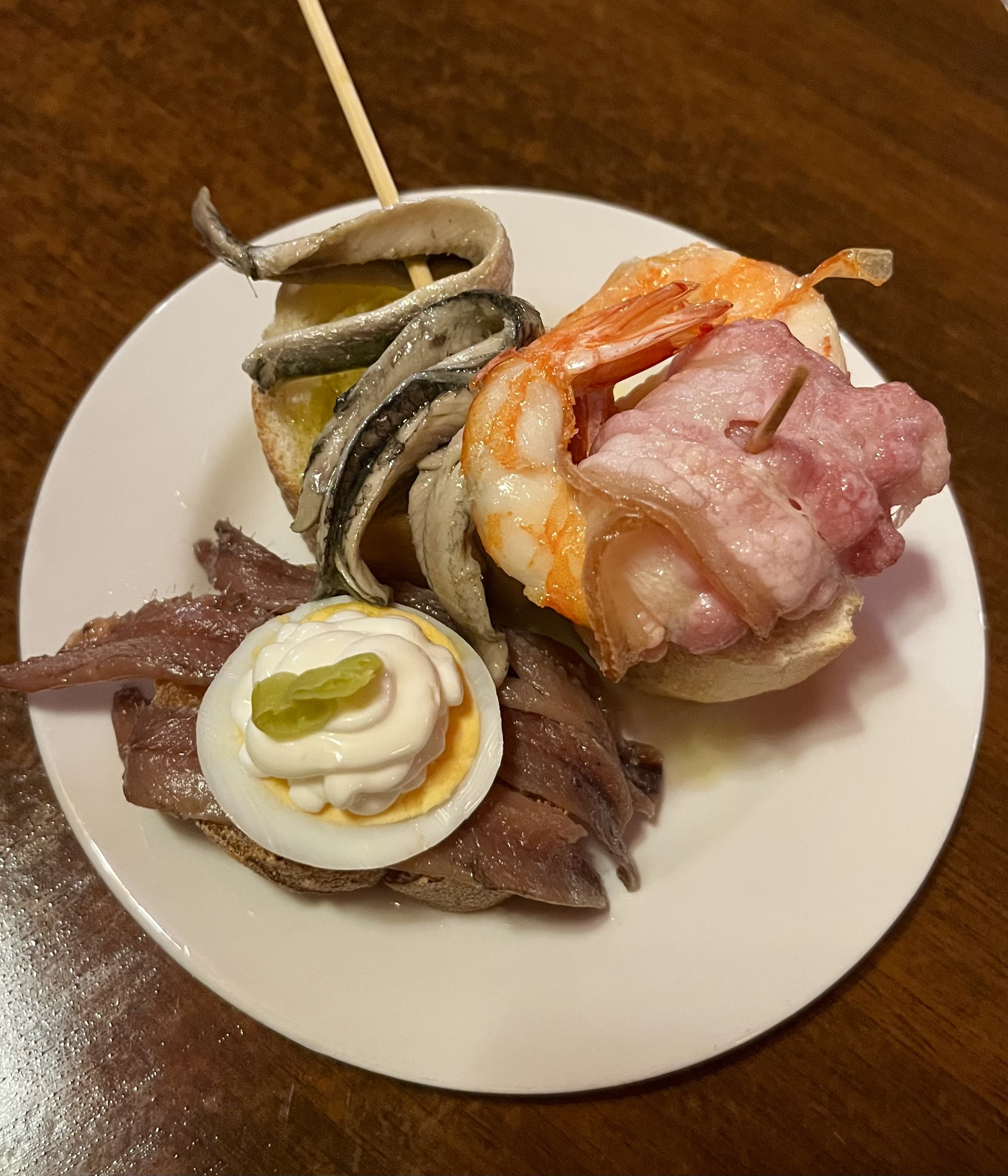Day 3 to Ziortza-Boliba
6 September 2023 Day 3 was a 49km day
Destination is the Monesterio de Zennarruza (it will be epic !)
Pilgrim or sojourner, or simply a bike ride in northern Spain that is the question of the day..
I will try to give my thoughts in the blog as I’ve thought about it extensively and have some definite opinions about it developed during my training walks back home. This answer will most likely become visible in my daily rumiinations and images posted on this blog.
Pilgrimage (ˈpilɡrəmij • a journey to a place associated with someone or something well known or respected)
What is my most basic definition? At the risk of sounding vague and prolix I came up with the following on a training walk back home earlier this summer::
1 There are others who have done the same journey, or are taking the same journey, but not necessarily at the same time
2 There is an innate and understood need to do whatever it is that is done (expressed or otherwise)
3 It takes a relatively long time
4 It is not easy to accomplish
5 It is physically demanding, and there might have a cost tied to it
6 It is a journey loosely defined often traveling by foot, or some other means that require effort
7 It goes from (a) point A to (a) point B
8 There IS an implicit meaning (it is not necessarily defined or definable by the pilgrim)
9 For some a religion dictates what it is
10 But while the ‘how’ may have been replicated by others, my ‘participation’ may ‘look’ different in methodology and duration
11 There is an outcome that is intellectually physically, emotionally, and spiritually satisfying (all)
12 There are aspects or components to the journey that are not easily quantifiable or definable or explainable before during or after
In my case, I don’t participate to seek a specific reward (as some do) -but I have found and do find an incalculable ‘reward’
~in the process itself,
therefore, as some already know, my last, Camino has made the top 10 list of my entire life…. but I find it impossible to sum up in a nutshell or paragraph or chapter book….what it is. Most others I’ve met agree it is not easy to articulate at all.
This is a common phenomenon of those that have done a Camino!
From Zarautz to Getaria the Mar Cantábrico or Cantabrian Sea is the term used mostly in Spain to describe the coastal sea of the Atlantic Ocean that borders the northern coast of Spain and the southwest side of the Atlantic coast of France, included in the Bay of Biscay
From my Guidebook Comments about the Deba (coastal) area:
Embarking on the journey from Deba to Markina-Xemein unveils a stretch that is notably serene yet distinctly solitary along the Camino del Norte. With few intermediary services available, it's essential to carry water and provisions to sustain you.
This leg of the journey carries you through mountainous terrain, a landscape largely devoid of settlements. The unique combination of its topography, characterized by pronounced elevation changes, makes it one of the most revered sections of the Camino del Norte.
While challenging, this segment's beauty shines through, offering picturesque glimpses into the idyllic rural valleys of the Basque region – a canvas painted with farmhouses, woodlands, and meadows. Once you reach the Calvario hermitage, the route takes you away from the coast. For several days, you'll bid farewell to the sea's presence until you reach Portugalete and Pobeña.
The most substantial ascent of this section occurs at the Arno pass, beyond Olatz, where you'll climb 300 meters in just 3 kilometers (that’s an oof-dah)
Note for Cyclists (Bicigrinos): Among the segments of the Northern Route, this stretch between Deba and Markina is renowned as one of the most formidable. Cyclists who embark on this path may not complete the official route, as they must follow the road. In essence, follow the road toward Mutriku and Ondarroa. Upon reaching Ondarroa, trace the Artibai River until you reach Markina-Xemein.
As you set your feet upon this path, prepare to embrace solitude, appreciate the rugged beauty, and discover the deep sense of accomplishment that accompanies conquering this stretch of the Camino del Norte.
It’s the beginning of my ride and I’m trying to figure out the elevation changes and what they really mean in terms of typical percent grade and effort required, but ultimately found out later in the cycling stage is that huge sprocket that’s the size of a dinner plate became my best friend! And resigned to frequent cycling at speeds equal to walking at 1 to 5 km/hr
Frequently, I am astounded at the scenery, like pictured below, that I’m actually cycling in such beautiful surroundings, in such an incredible country next to the sea. I love to stop, catch my breath and soak it in and try to capture full color permanent memories.
So what about Basque Country, culture, current politics, and the food?
On the border with France lies the autonomous Basque region, bathed in the strong sun of Biscay Bay [Pais Vasco (in Spanish) or Euskadi (in Basque)]. This exciting region has its own culture and language. Along the coast, you will find one cute seaside towns, one after another, all flanked by beautiful beaches, and beautiful walks through the green rolling countryside. The hinterland features old market towns and forested mountains with scores of ancient monasteries and castles just waiting to be explored.
The Basques are a very hospitable people, always glad to share their proud heritage with visitors. They are extremely warm, who would welcome you back time after time. The Basque cuisine is based on the rich gastronomic traditions and is generally deemed Spain’s best. This gastronomic mecca has a wide range of world-renowned Michelin restaurants although there are many other opportunities to sample its fantastic cuisine.
Each night I would go to a nearby bar ( in Spain, cafés and restaurants are called bars) and order tapas. Some mornings. I did the same as the offerings were highly varied and very delicious and I grabbed all the calories I had room for. I estimate my daily requirement at a minimum of 3500 calories per day. Standard operating procedure each morning: I start with a café con leche, and a croissant, and if possible jugo de naranja (OJ)
Exquisite ‘bocadillo’ tapas snack. Shop owners are expert at cutting ham paper thin!
What I enjoyed is that in most towns you can pick and choose from an endless offering of quaint tapas bars each that offer a wide variety of tapas - or “pinxchos” as tapas are called in this area. Portion size is small but that’s part of a joy as I typically ordered 2 to 4 items at each setting. They are very low cost and all hand prepared - hecho a mano!
The cuisine is traditionally based on quality products and simple cooking. It is an artisanal, culinary art, where the sea ( and pork) provides a part of the key ingredients to the exquisite cuisine. Seafood and red meat are the cornerstones. Cheese and other dairy products are also widely used in traditional Basque cuisine.
Politics? You can look it up . There is a large separatist movement within this region, often visible in signage and street graffiti like this below
Separatist sentiments
The rest of the days riding was slow with a very difficult long, ascents in 1st gear and followed by fun, but not so restful decents ripping down the mountain highways at breakneck speeds. Fortunately, most of the drivers are Spanish, and give cyclists a very wide berth as they themselves go around also at high speeds. In genearal they are much more attentive and respectful to cyclists than highly distracted American drivers.
a lot of details to decipher on Camino signage
What stories could this place tell about ‘its day’
Church at crossroads in Artibai Ibaia, Markina-Xemein, Bizkaia (Bassque and spanish names)
Well, to be honest, road riding clearly introduce risk in my daily program. My comfort level was such that I was OK on roads, with precautions I took as well as my rear facing, blinking, very bright, red light.
Simon Bolibar Plaza (Camino cross-roads for biking & walking)
Access the 15th century Monastery of Zenarruza along the remains of an ancient cobbled road, used in the past by pilgrims to Santiago. (I had to bike via the road however)
As I rode away from Bolobar plaza up the road to the monastery -here’s the turn off for the walkers -(not bikable due to incline), so I was thankful to see the cycle arrow on the sign at left. (This segment and town bears witness to significant historical events. Passing through Bolibar, the birthplace of the ancestral liberator Simón Bolívar, you'll then reach Gernika, known worldwide for the tragic events of April 1937, immortalized in Pablo Picasso's renowned masterpiece "Guernica.")
The chance to stay in a remote monastery that dated back to the 10th century (as a church run ‘hospital’ (14th century) couldn’t be passed up.
The Monastery was founded sometime in the 900s. The story goes that, at the Feast of the Assumption on August 15, 968, the people of Gerrikaitz were celebrating mass when an eagle swooped in to the ossuary of the cemetery and seized a skull in its claws. The people followed it as it flew until it reached the slope of Zenarruza, in the foothills of Mount Oiz, where it dropped the skull. The skull fell into a thick patch of dwarf elder. The people took this as a sign that they should build a hermitage to the Virgin on that slope.
The coat-of-arms of the Monastery features the eagle and skull.
The Monasterio de Zenarruza became a key part of my 2023 Camino story along with a stellar picture from across the valley on my onward bicycling tomorrow.
The cloister of Zenarruza inspires, like almost everything else on this site. Old and moss-covered, the grass-filled courtyard reflected light onto delicate arches etched with the scallop shell and the cross of St James himself.
What’s wonderful about staying in a place such as a monastery or a hostel or an albergue is that you meet many people from all over Europe and around the world, have a great time, and form simple emotional social connections that will be remembered for many years to come.
Three cross approach to the Monasterio de Zenarruza property (photo credit to Beth J - 7/2018)
My first room assignment after parking my bicycle was upper bunk in a room for 6 pilgrims, but……
Not finding me checked in on the ‘reservation roster’ a monk came to me later in the hostel and said my travel agency had assigned me to a private room an in renovated part of the monastery adjacent to the sanctuary !
As always ! get the daily laundry done before dinner and get it drying as much as possible before morning.
Below is our (my first) communal dinner, which was very enjoyable, preceded by many with copious amounts of beer and wine. A lot of latecomers but nobody was turned away even though the rooms were essentially sold out as it is not always necessary to make reservations along the Camino- our hosts eventually found a place to put everybody -some of the latest arrivals simply slept outside while some slept on the floor in a parking garage. The Camino provides!
One of many shared meals common at albergues on Camino, while I don’t remember many names I will treasure each of you and that evening in my heart !
Typical display of food at a tapas bar (tomorrow mornings wonderful ‘find’ in Gernika) -pick and choose what you will. Spanish tortilla bottom, flan sweets above, bocadillo sandwiches left, and the ever present croissants. They generally range from 2 to 4 euro.
Aritistic tapas offerings- some are works of art; Anchovies, sardines, bacon and shrimp …. what more could a calorie devouring bicyclist want !
Highlight of the day:
First communal dinner at the epically beautiful and contemplative Monasterio de Zenarruza
Declared a National Monument of the Basque Country, the Monastery of Zenarruza, a former collegiate church, stands at the foot of Mount Oiz (1,026 m) just a few kilometres from the town of Bolibar, Bizkaia. Considered one of the territory's treasures, it was an important enclave on the Coastal Way of St James during the Middle Ages and, especially, the Renaissance.
You can access the Monastery of Zenarruza along the remains of an ancient cobbled road, used in the past by pilgrims to Santiago. The monastery complex includes a 15th century Gothic-Renaissance style church (its highlight is the Plateresque altarpiece of the high altar), a beautiful mid-16th century cloister and the different buildings of the cloister and community life such as the abbot's house, the settlers houses and the refectory.
This eventually elevated the church from a Parish to a Collegiate Church, which, while not overseen by a bishop, was still able to offer some of the same services as a cathedral. This happened in 1379.
It was the first Collegiate Church of Bizkaia.
After its heydays, the Collegiate began to slowly deteriorate and it lost its status as a Collegiate Church in 1851.
In 1948, the church once at the heart of the Collegiate, renown for its beauty, was named a national monument of Euskadi. In 1988, a group of Cistercian monks, from the abbey of Santa Maria de Olive in Navarra, moved in, turning the former Collegiate into a monastery. It has since been updated and maintained to accommodate both no reservation pilgrims and those reserving rooms in the newer section.
What surprised me most:
The universal friendliness and camaraderie of all present at today’s beautiful lodging -restful and contemplative with a beautiful sanctuary.
“The geographical pilgrimage is the symbolic acting out an inner journey. The inner journey is the interpolation of the meanings and signs of the outer pilgrimage. One can have one without the other. It is best to have both.”
~ Thomas Merton
